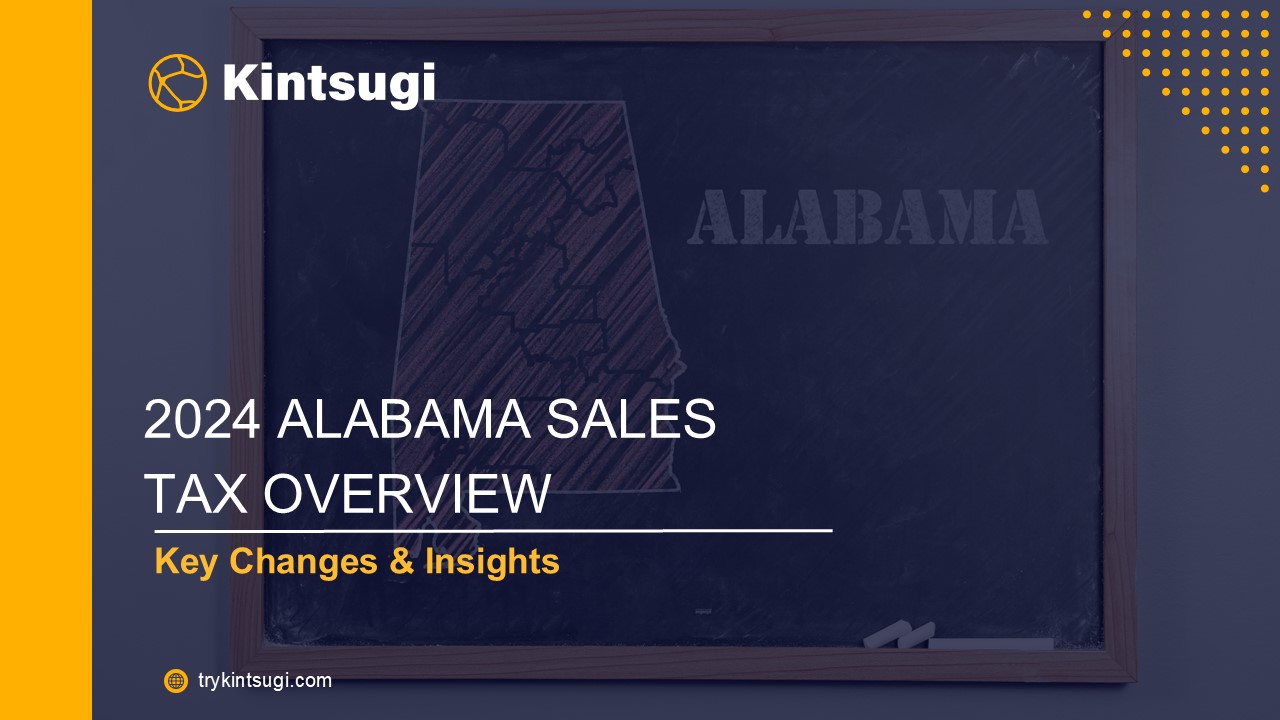2024 Alabama Sales Tax Overview: Key Changes & Insights - PowerPoint PPT Presentation
Title:
2024 Alabama Sales Tax Overview: Key Changes & Insights
Description:
Discover the latest updates on Alabama's sales tax for 2024, including state, county, and city tax rates, new exemptions, and key changes like grocery tax reductions and incentives for electric vehicles. Stay informed on how these updates impact businesses, consumers, and remote sellers. – PowerPoint PPT presentation
Number of Views:0
Title: 2024 Alabama Sales Tax Overview: Key Changes & Insights
1
2024 ALABAMA SALES TAX OVERVIEW
Key Changes Insights
trykintsugi.com
2
INTRODUCTION
Welcome to Kintsugi's comprehensive overview of
sales tax in Alabama for 2024. This presentation
will explore the state sales tax rates, county
and city variations, recent changes, and how
these affect businesses and consumers alike.
The purpose of this presentation is to inform
stakeholders, including business owners,
consumers, and tax professionals, about the
current state of sales tax in Alabama. We will
cover the basics, recent changes, and the
implications for different entities.
3
STATE SALES TAX RATE
Base State Sales Tax Rate
- 4 (unchanged from 2023).
- This rate serves as the foundation for
calculating sales tax across Alabama, affecting a
wide range of goods and services.
The state sales tax is applied to most retail
sales, leases, and rentals of tangible personal
property. This consistent 4 rate helps maintain
stability for consumers and businesses alike in
budgeting and financial planning.
4
COUNTY SALES TAX RATES
County Sales Tax Rate Range
- Ranges from 0.5 to 5, depending on the county.
- Highest Rate Wilcox County at 6.
- Lowest Rate Bullock County at 2.
Counties in Alabama have the authority to levy
their own sales taxes on top of the state tax,
resulting in variations that can significantly
impact local economies. The additional revenue
supports county services such as education,
public safety, and infrastructure.
5
CITY SALES TAX RATES
City Sales Tax Rate Range
- Fluctuates between 1 and 7.5.
- Birmingham Maintains a rate of 4.
- Montgomery Adjusted from 3.5 to 3.75 in 2024.
City sales taxes are often implemented to fund
local initiatives and services, such as parks,
public transportation, and city infrastructure.
This variation necessitates careful consideration
for consumers and businesses operating in
multiple locations.
6
COMBINED SALES TAX RATES
Combined Sales Tax Rates
- Can range from 5.5 to 10.5 across Alabama.
- For example, consumers in Montgomery could
experience rates up to 11 due to city tax
increases.
Understanding the total sales tax burden is
crucial for consumers when making purchases and
for businesses calculating their pricing
strategies. The combined rate reflects both state
and local taxes, which can significantly impact
consumer behavior.
7
SPECIAL SALES TAX DISTRICTS
Special Districts
- Certain districts have unique rates designed to
support local projects. - For example, Auburn's special district tax has
risen from 1 to 1.25 in 2024.
Special tax districts are created to fund
specific projects or improvements in designated
areas. These funds often go toward community
development, infrastructure improvements, and
enhancing local services, which can drive
economic growth in those areas.
8
CALCULATING SALES TAX
How to Calculate Sales Tax
- Use the formula
- Sales Price (State Tax Rate Local Tax Rate)
Total Sales Tax - Example For a 100 purchase in a city with a 3
local tax - 100 (4 3) 100 0.07 7.
Accurate sales tax calculation is vital for
compliance with tax laws. This example
illustrates how to factor in both the state and
local tax rates to determine the total amount
owed. Understanding this process can help
consumers anticipate costs and businesses to
remain compliant.
9
UNDERSTANDING USE TAX
Use Tax Overview
- Levied on goods purchased outside the state for
use, storage, or consumption within Alabama. - If an item is bought without paying Alabama sales
tax, the buyer must pay use tax, which is
equivalent to the state sales tax rate (4).
The use tax serves to level the playing field
between local retailers and out-of-state sellers.
Consumers are responsible for reporting and
paying this tax on items purchased from outside
the state if sales tax was not collected at the
time of purchase.
10
RECENT CHANGES IN 2024
Key Changes Effective 2024
- General sales tax rate remains at 4.
- Grocery tax reduced from 4 to 3 to ease
inflation impacts. - Increased economic nexus threshold for remote
sellers from 250,000 to 300,000.
These changes reflect Alabama's efforts to adapt
to economic conditions and support residents and
businesses. The reduction in grocery tax is
particularly significant for low- to
middle-income households, helping to mitigate the
effects of inflation on essential goods.
11
EXEMPTIONS AND NEW RULES
Exemptions Introduced in 2024
- Certain agricultural equipment exempt from state
sales tax. - Small businesses with gross sales under 100,000
are now exempt from state sales tax, up from
75,000.
These exemptions aim to foster entrepreneurship
and support local economies. The increase in the
exemption threshold for small businesses is
expected to reduce the tax burden on newer and
smaller companies, enabling them to grow and
contribute more significantly to the economy.
12
PROMOTING GREEN INITIATIVES
Electric Vehicles (EVs)
- Sales tax reduced to 2 for EVs (previously 4)
to promote greener transportation options.
The reduced sales tax on electric vehicles is
part of a broader strategy to encourage
environmentally friendly practices and align with
national goals for reducing carbon footprints.
This initiative not only benefits consumers but
also promotes the growth of the EV market in
Alabama.
13
SUMMARY OF KEY INSIGHTS
RECAP OF ALABAMA SALES TAX IN 2024
- Base state tax rate remains steady.
- Local variations affect overall tax burden.
- Significant reductions for groceries and new
exemptions for small businesses aim to ease
financial pressures. - Changes reflect a focus on supporting local
economies and sustainability.
14
THANK YOU
For more information, contact us































